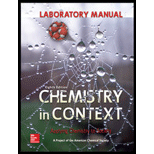
(a)
Interpretation:
The statement, liberation of more heat per gram by hydrocarbon fuel containing larger molecule than smaller molecule has to be validated using the given data.
Concept Introduction:
Molar heat of combustion: It is the amount of heat released when one mole of hydrocarbon is burnt with excess of oxygen.
Heat of combustion per gram: It is the amount of heat liberated when one gram of hydrocarbon is burnt with excess of oxygen.
Heat of combustion per gram can be calculated as follows,
(a)
Explanation of Solution
Given,
Since, octane has more atoms and more bonds, molar heat of combustion is more for octane than butane. But for comparison same amount of substance should be taken. So, heat released from each gram of substance has to be calculated as follows,
From the calculation, the amount of heat released by one gram of butane is slightly more than the amount of heat liberated from one gram of octane. Since, the amount of heat liberated from octane and butane have very small difference it is not possible to establish a trend using only two data. Even though from the calculation, butane the smaller hydrocarbon release more energy than the larger octane.
So the statement is wrong, because comparison should be done by taking same mass of fuel not same number of mole.
(b)
Interpretation:
Heat of combustion per gram and molar heat of combustion of candle wax and octane has to be compared.
Concept Introduction:
Molar heat of combustion: It is the amount of heat released when one mole of hydrocarbon is burnt with excess of oxygen.
Heat of combustion per gram: It is the amount of heat liberated when one gram of hydrocarbon is burnt with excess of oxygen.
Heat of combustion per gram can be calculated as follows,
(b)
Explanation of Solution
Candle wax
But, the molar heat of combustion of candle wax will be higher than the molar heat of combustion of octane.
Want to see more full solutions like this?
Chapter 4 Solutions
Laboratory Manual Chemistry in Context
- Determine if the following salt is neutral, acidic or basic. If acidic or basic, write the appropriate equilibrium equation for the acid or base that exists when the salt is dissolved in aqueous solution. If neutral, simply write only NR. Be sure to include the proper phases for all species within the reaction. NaN₃arrow_forwardCan I please get help with this?arrow_forwardCan I please get help with this?arrow_forward
- Use the Henderson-Hasselbalch equation to calculate pH of a buffer containing 0.050M benzoic acidand 0.150M sodium benzoate. The Ka of benzoic acid is 6.5 x 10-5arrow_forwardA. Draw the structure of each of the following alcohols. Then draw and name the product you would expect to produce by the oxidation of each. a. 4-Methyl-2-heptanol b. 3,4-Dimethyl-1-pentanol c. 4-Ethyl-2-heptanol d. 5,7-Dichloro-3-heptanolarrow_forwardWhat is the pH of a 1.0 L buffer made with 0.300 mol of HF (Ka = 6.8 × 10⁻⁴) and 0.200 mol of NaF to which 0.160 mol of NaOH were added?arrow_forward
- Can I please get help with this.arrow_forwardDetermine if the following salt is neutral, acidic or basic. If acidic or basic, write the appropriate equilibrium equation for the acid or base that exists when the salt is dissolved in aqueous solution. If neutral, simply write only NR. Be sure to include the proper phases for all species within the reaction. N₂H₅ClO₄arrow_forwardPlease help me with identifying these.arrow_forward
 ChemistryChemistryISBN:9781305957404Author:Steven S. Zumdahl, Susan A. Zumdahl, Donald J. DeCostePublisher:Cengage Learning
ChemistryChemistryISBN:9781305957404Author:Steven S. Zumdahl, Susan A. Zumdahl, Donald J. DeCostePublisher:Cengage Learning ChemistryChemistryISBN:9781259911156Author:Raymond Chang Dr., Jason Overby ProfessorPublisher:McGraw-Hill Education
ChemistryChemistryISBN:9781259911156Author:Raymond Chang Dr., Jason Overby ProfessorPublisher:McGraw-Hill Education Principles of Instrumental AnalysisChemistryISBN:9781305577213Author:Douglas A. Skoog, F. James Holler, Stanley R. CrouchPublisher:Cengage Learning
Principles of Instrumental AnalysisChemistryISBN:9781305577213Author:Douglas A. Skoog, F. James Holler, Stanley R. CrouchPublisher:Cengage Learning Organic ChemistryChemistryISBN:9780078021558Author:Janice Gorzynski Smith Dr.Publisher:McGraw-Hill Education
Organic ChemistryChemistryISBN:9780078021558Author:Janice Gorzynski Smith Dr.Publisher:McGraw-Hill Education Chemistry: Principles and ReactionsChemistryISBN:9781305079373Author:William L. Masterton, Cecile N. HurleyPublisher:Cengage Learning
Chemistry: Principles and ReactionsChemistryISBN:9781305079373Author:William L. Masterton, Cecile N. HurleyPublisher:Cengage Learning Elementary Principles of Chemical Processes, Bind...ChemistryISBN:9781118431221Author:Richard M. Felder, Ronald W. Rousseau, Lisa G. BullardPublisher:WILEY
Elementary Principles of Chemical Processes, Bind...ChemistryISBN:9781118431221Author:Richard M. Felder, Ronald W. Rousseau, Lisa G. BullardPublisher:WILEY





